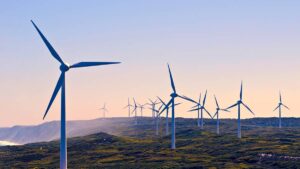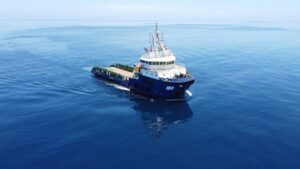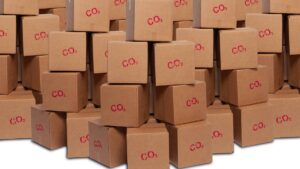Power Up: Cannon-Brookes’ Sun Cable win shows the growing appetite for renewables

Are we biting into more renewable energy now? Pic: Iuliia Bondar via Getty Images
The tussle between Australian billionaires Andrew Forrest and Mike Cannon-Brookes over the fate of the ambitious Sun Cable renewable energy project has concluded in the latter’s favour.
Which means that the plan to spend something on the order of $30bn to build the world’s largest solar farm backed by an equally massive battery and a cable to take electricity generated or stored by the project to Singapore is back on.
Or is it?
After all there are plenty of arguments against its viability, with critics pointing to the multitude of challenges be they technical, political or financial.
But this is not about whether Sun Cable is viable or not, rather Power Up would just like to take the opportunity to point out that the willingness of the two billionaires to even battle it out for the right to throw large sums of money at a project with so many challenges is a clear sign that transition towards renewable energy is well and truly accelerating.
And there are more examples of this.
Philippines based renewable energy major Acen – part of the Ayala Group – has secured approval to double the size of its solar battery that’s attached to its 720MW New England solar farm (near Uralla, NSW) to 2.8 gigawatt hours, enough for two hours of storage.
This will play a significant role in stabilising the grid in NSW, which has been steadily retiring its coal-fired power plants.
More broadly, energy consultancy Wood Mackenzie has noted that global wind turbine orders have increased by a healthy 27% in the first quarter of 2023 with China accounting for nearly two-thirds of the 23.5GW of generation they are rated for.
Likewise, US wind turbine orders more than doubled to 1.8GW, surpassing the total for the first half of 2022.
On the domestic front, AGL certainly seems to agree that wind will play a key role in the future energy mix with the energy giant joining a consortium including Ireland’s Mainstream Renewable Power, Canada’s Reventus Power, and Australia’s Direct Infrastructure to build a 2.5GW offshore wind project in Gippsland.
Beach Energy – better known for its oil and gas operations in South Australia’s Cooper Basin – has also put its hand up for a offshore wind power licence off Victoria, taking a 25% in a project proposed by European group Parkwind.
Green hydrogen is also emerging as a valuable store of excess renewable energy with the Federal and Queensland governments committing $117m to 3GW hydrogen project in Gladstone Queensland that is being developed by Stanwell, APA Group and several Japanese energy companies.
Australia will need every iota of renewable energy
All these efforts will find a place in Australia’s future energy mix because we will quite frankly need every scrap of renewable energy that we can get out hands on in order to achieve net zero amidst growing energy demand by 2050.
The CSIRO has already flagged that the National Electricity Market would require up to a 14-fold increase in its electricity storage capacity between 2025-2050 to meet demand.
As highlighted by our very own Jessica Cummins, this will require all forms of energy storage including lithium ion batteries, pumped hydro (like the troubled Snowy Hydro 2.0 project), chemical storage (hydrogen), or even thermal storage like molten salts.
More recently, South Australian transmission company ElectraNet has noted that green industrial growth and the shift to electric vehicles could double the State’s electricity usage by the end of the decade.
This will require a substantial increase in renewable energy generation particularly if the State wants to achieve its goal of 100% renewables well before 2030.
Not all smooth sailing
But if we are going to achieve this transition, more needs to be done sooner.
Rather worryingly, the Clean Energy Council has noted that while clean energy construction hit a peak in the first quarter of 2023, no new generation projects reached financial close in the same period.
And to compound problems, just one 200MW/400MWh big battery project reached financial close this quarter.
“Australia needs to double the rate of renewable energy deployment to ensure we have enough new supply to drive down power prices, replace exiting coal generation and ensure we achieve the target of 82% renewable energy by 2030 and put Australia on a path to achieve net-zero by 2050,” CEC chief executive Kane Thornton said.
“A slowdown in the rate of new projects reaching financial close is at odds with our need to accelerate deployment. While energy investors are enthusiastic about investing in clean energy in Australia, there are a variety of headwinds that are undermining confidence at present.”
Clearly more needs done and sadly, this is one area where the government – whether at the Federal or State level – needs to step in to make investment in renewable energy more attractive whether by making the economics more attractive, improving the regulatory environment, or both.
Related Topics
UNLOCK INSIGHTS
Discover the untold stories of emerging ASX stocks.
Daily news and expert analysis, it's free to subscribe.
By proceeding, you confirm you understand that we handle personal information in accordance with our Privacy Policy.








